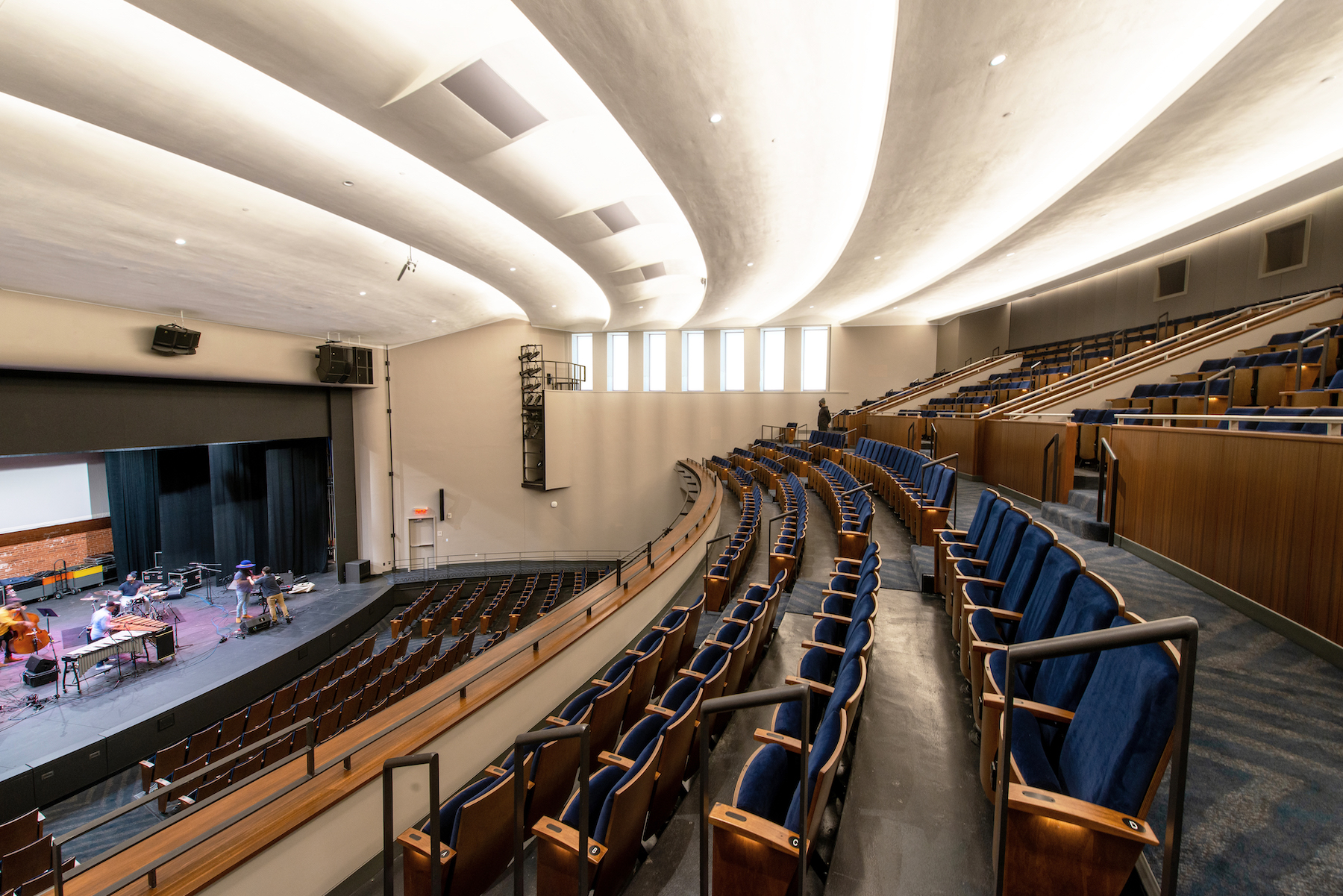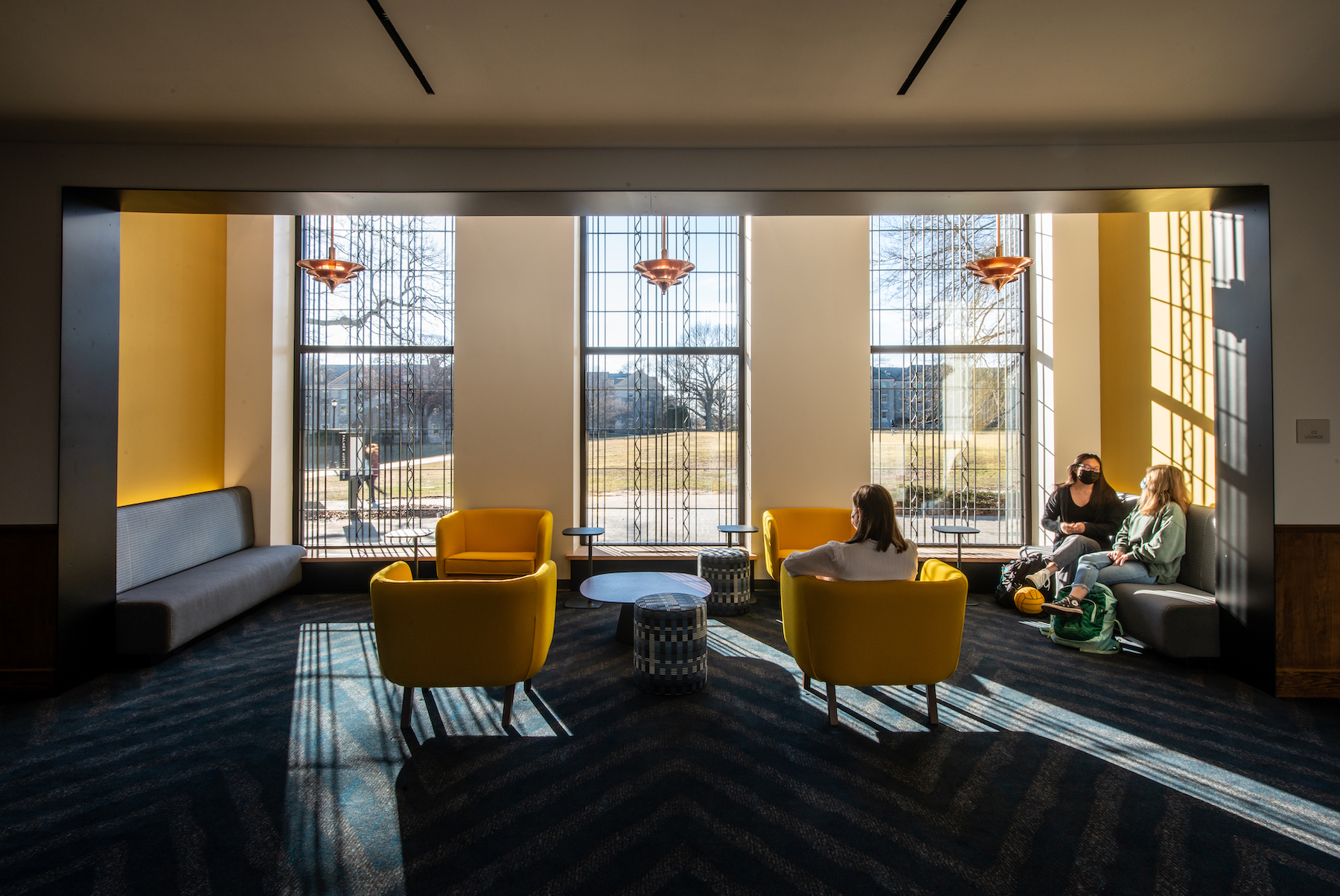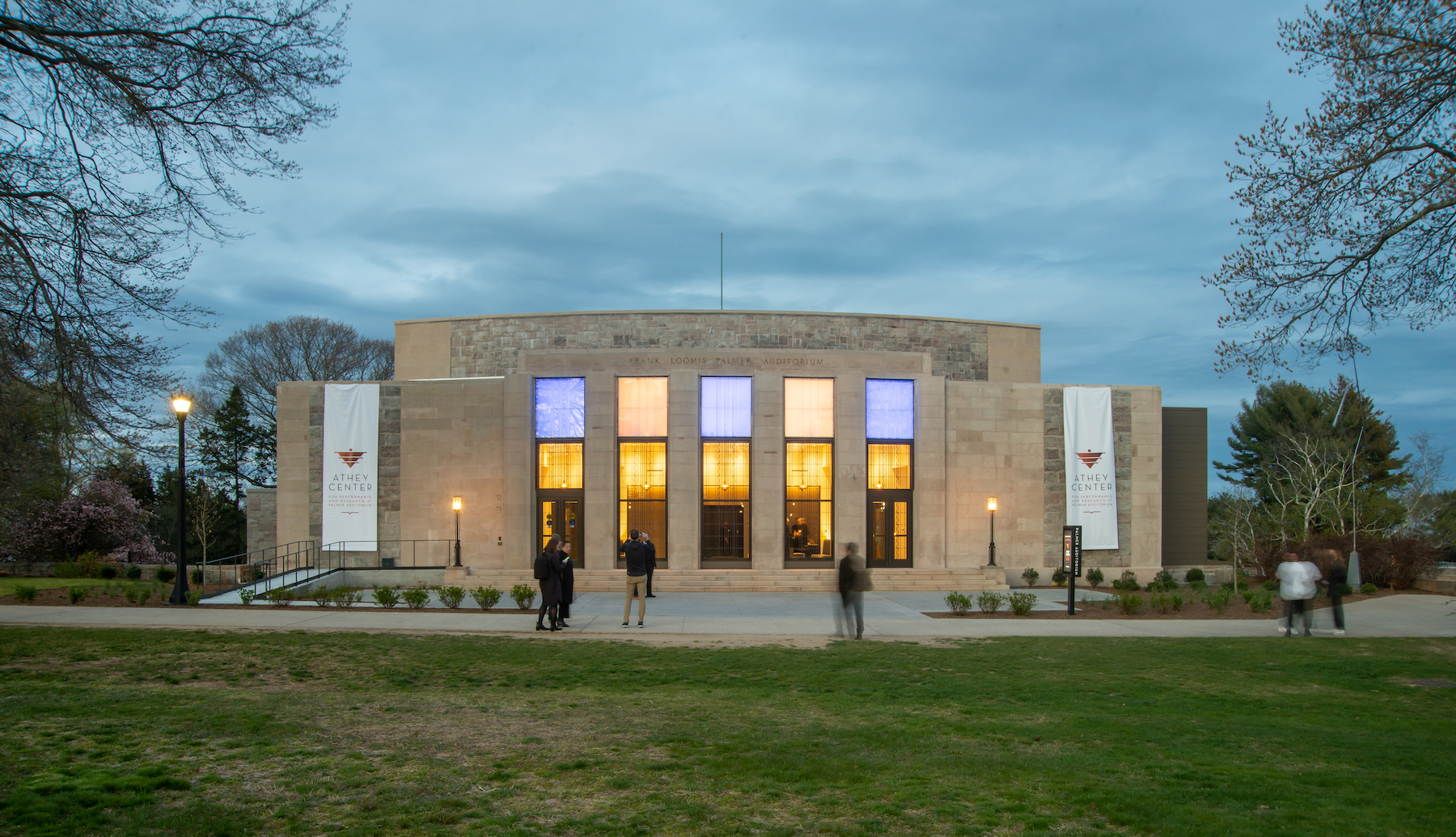Palmer Auditorium, on the campus of Connecticut College in New London, is an Art Deco theater designed by William F. Lamb in 1939, who also designed the Empire State Building in New York City. The theater has a long history of hosting acclaimed artists, musicians, and performers, from Dizzy Gillespie to Yo-Yo Ma.
This spring, the 38,500-sf building entered a new era, thanks to its new name—the Athey Center for Performance and Research at Palmer Auditorium—and a $23 million renovation by a team that included the architecture firm Ennead Architects, which modernized the facility to support teaching, learning and performance across a spectrum of disciplines.
The project dates back to 2018 and took 24 months of construction. It was completed in April, and included a new entrance, façade renewal, and interior renovation to the auditorium, lobbies, lounges, costume and workshop, as well as the teaching, administrative, and support spaces.
“A lot of things needed improvement,” says Brian Masuda, Associate Principal with Ennead Architects, whom BD+C interviewed with Molly McGowan, a Partner at the firm. Prior to the renovation, clerestories in the auditorium had been boarded up, and the building, says Masuda, “was very dark, and kind of shut off from the rest of the campus.” So it was imperative to bring more natural light into the building, including onto its historic wood stairs that were preserved and restored.

The renovation opened up three sides of the building with glass door fronts and feature walls. On the building’s historic side, the team replaced deteriorating spandrels with lightboxes made with cast glass. And where appropriate, transparent materials were used. Inside, the lobby window looks down onto the studio. And the theater department, which had been scattered throughout the building, was consolidated within one wing.
McGowan says the renovation “recognizes the history of the building” while, at the same time, making what is now part of the college’s Theater Department more modern. The challenge, says Masuda, was blending the old and the new, from rehanging the lobby’s lighting pendants to adding modern furniture and new carpeting with an Art Deco-like chevron pattern.
SUBTLE RENOVATION ADDITIONS

About 500 usable square footage were added to the building during the renovation. By making small adjustments to the building plans within the existing footprint, Ennead created a new lounge area and box office with an expanded public lobby. The lobby spaces on two levels were re-imagined to serve as informal teaching and study spaces. Two key elements were introduced at the main level lobby: a highly visible entry to the Theater Department’s administrative suite and a visual connection to the newly created teaching studio.
The auditorium seating now provides access that complies with the Americans with Disabilities Act, as well as improved sight lines, better acoustics, a new state, and visual technology upgrades.
“The renovations have resulted in a magnificent transformation that promises to make the Athey Center a destination for the region and an inspiration for future generations of student performers ready to make a difference with their art,” said Connecticut College’s president Katherine Bergeron.
The Building Team on this project included A/Z Corp (GC), Altieri (ME), Silman (SE), and Next Stage (theatrical consultant).
Related Stories
| Aug 11, 2010
Curtain rises on Broadway's first green theater
The Durst Organization and Bank of America have opened New York's first LEED-certified theater, the 1,055-seat Henry Miller's Theatre. Located inside the new 55-story Bank of America Tower at One Bryant Park, the 50,000-sf theater is located behind the preserved and restored neo-Georgian façade of the original 1918 theater.
| Aug 11, 2010
Restoration gives new life to New Formalism icon
The $30 million upgrade, restoration, and expansion of the Mark Taper Forum in Los Angeles was completed by the team of Rios Clementi Hale Studios (architect), Harley Ellis Devereaux (executive architect/MEP), KPFF (structural engineer), and Taisei Construction (GC). Work on the Welton Becket-designed 1967 complex included an overhaul of the auditorium, lighting, and acoustics.
| Aug 11, 2010
Gold Award: Eisenhower Theater, Washington, D.C.
The Eisenhower Theater in the John F. Kennedy Center for the Performing Arts in Washington, D.C., opened in 1971. By the turn of the century, after three-plus decades of heavy use, the 1,142-seat box-within-a-box playhouse on the Potomac was starting to show its age. Poor lighting and tired, worn finishes created a gloomy atmosphere.
| Aug 11, 2010
Giants 300 University Report
University construction spending is 13% higher than a year ago—mostly for residence halls and infrastructure on public campuses—and is expected to slip less than 5% over the next two years. However, the value of starts dropped about 10% in recent months and will not return to the 2007–08 peak for about two years.
| Aug 11, 2010
Bowing to Tradition
As the home to Harvard's Hasty Pudding Theatricals—the oldest theatrical company in the nation—12 Holyoke Street had its share of opening nights. In April 2002, however, the Faculty of Arts and Sciences decided the 1888 Georgian Revival building no longer met the needs of the company and hired Boston-based architect Leers Weinzapfel Associates to design a more contemporary facility.
| Aug 11, 2010
Team Tames Impossible Site
Rensselaer Polytechnic Institute, the nation's oldest technology university, has long prided itself on its state-of-the-art design and engineering curriculum. Several years ago, to call attention to its equally estimable media and performing arts programs, RPI commissioned British architect Sir Nicholas Grimshaw to design the Curtis R.
| Aug 11, 2010
Silver Award: Hanna Theatre, Cleveland, Ohio
Between February 1921 and November 1922 five theaters opened along a short stretch of Euclid Avenue in downtown Cleveland, all of them presenting silent movies, legitimate theater, and vaudeville. During the Great Depression, several of the theaters in the unofficial “Playhouse Square” converted to movie theaters, but they all fell into a death spiral after World War II.
| Aug 11, 2010
Biograph Theater
Located in Chicago's Lincoln Park neighborhood, Victory Gardens Theater Company has welcomed up-and-coming playwrights for 33 years. In 2004, the company expanded its campus with the purchase of the Biograph Theater for its new main stage. Built in 1914, the theater was one of the city's oldest remaining neighborhood movie houses, and it was part of Chicago's gangster lore: in 1934, John Dillin...
| Aug 11, 2010
Platinum Award: Reviving Oakland's Uptown Showstopper
The story of the Fox Oakland Theater is like that of so many movie palaces of the early 20th century. Built in 1928 based on a Middle Eastern-influenced design by architect Charles Peter Weeks and engineer William Peyton Day, the 3,400-seat cinema flourished until the mid-1960s, when the trend toward smaller multiplex theaters took its toll on the Fox Oakland.







